So you’ve decided to launch your own dropshipping business. That’s it. You’re done going back and forth – you’re starting today. But, while this decision could change your life, it also comes with a lot of questions.
Where do I start? What should I sell? How do I find a dropshipping niche? What kind of income can I expect? And, can I succeed without any start up money?
Don’t worry. The most successful dropshippers started with the same questions and doubts. Mastering something new takes time, whether it’s playing an instrument, surfing, or dropshipping. With patience and determination, you’ll soon be a pro.
To help you, we’ve put together some tips and a list of ten key milestones for your first year in the dropshipping business. These tips are based on the experience of Nourdine, a young French dropshipper who inspired this article and whose story you will discover below. But before that, let’s have a look at some important facts about dropshipping.
Post Contents
- 4 Things to Know about Dropshipping
- Launching a Dropshipping Website: 10 Key Milestones for Your First Year
- 1. Learn the basics
- 2. Become digital-marketing savvy
- 3. Find the right products
- 4. Establish relationships with suppliers
- 5. Create a business plan
- 6. Build your site with UX in mind
- 7. Choose a payment platform
- 8. Invest in social media advertising
- 9. Optimize your customer relationship management (CRM)
- 10. Fail with your first dropshipping website and start again
- Insights From a French Dropshipper on His First Year in the Business
- 5 Tips for a New Dropshipper
- What’s Next for Nourdine?
- Want to Learn More?



4 Things to Know about Dropshipping
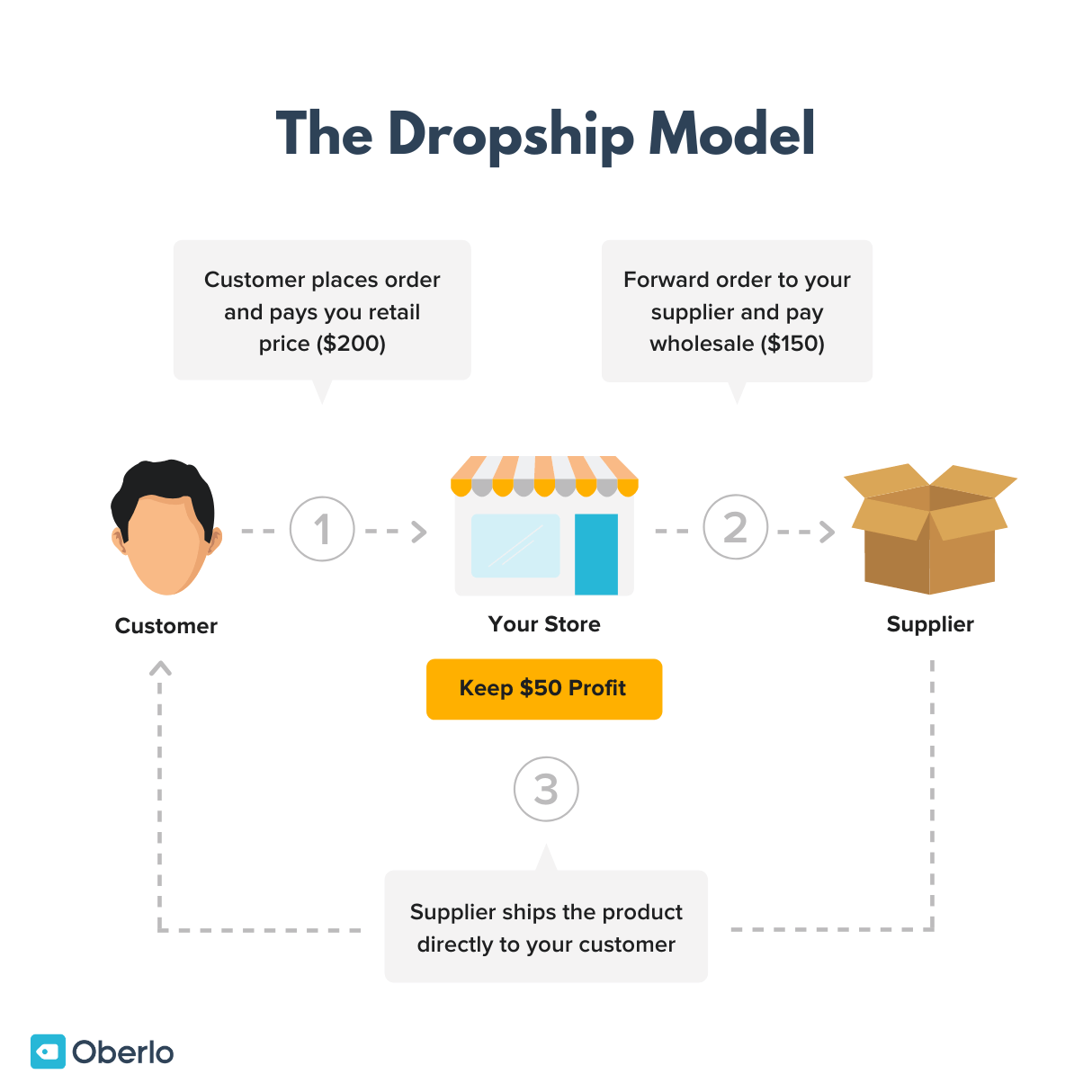
1. Dropshipping requires persistence
Many dropshippers set out with big ambitions and a lot of motivation expecting quick results. And that’s one of the most common beginner mistakes. You need to give yourself the time to learn, test, fail, and start over.
Some people will try dropshipping for two weeks, maybe a month, and give up if they don’t generate significant sales. In the beginning – and even after several months, you will suffer several failures: whether it’s a Facebook ad that doesn’t work, a product that doesn’t attract crowds, an audience that doesn’t respond well, or a store that doesn’t generate sales.
→ Click Here to Launch Your Online Business with Shopify
The possibilities for failure are endless. But the good news is that the opportunities for success are also unlimited. Don’t give up. Despite what most people think, dropshipping is not an easy business, and success won’t happen overnight. You will have to fight to succeed. And by making mistakes, you will learn a lot about your business and yourself. We recommend testing your business for a year to experience several failures and generate success and a regular stream of sales.
2. Dropshippers have a ‘test and learn’ approach
There are three rules to follow to succeed as a dropshipper: test, test, and test again. There is no miracle recipe for a successful campaign. Success lies in testing, but also in analyzing and learning from your trials. When you find something works or doesn’t work, it is important to reflect on these successes or failures.
Test your products in terms of quality but also in terms of interest. Be sure to test the efficiency of your dropshipping store and your advertising campaigns. Test several channels and see what works, either organically or through promotion. Test several sources of income, including dropshipping, affiliate marketing, and gig jobs. This will increase the cash you can dedicate to marketing in your first months. Test your skills. Try to work on weekdays and weekends, in a café or at home.
Test everything.
And most importantly, test yourself. Your values and resilience will be put to the test.
3. There are good and bad dropshippers
Just like with every business, there are good dropshippers and bad dropshippers. The good dropshipper has strong values and brings added value to customers with a quality product. He makes it easy to buy an item seen on a Facebook ad. A good dropshipper has a professional attitude, ethically manages his business, and sometimes creates jobs.
The bad dropshipper doesn’t focus on sourcing a good product but on his profit margin. A bad dropshipper sells inferior quality items or products based on fear, such as high priced masks during the COVID-19 pandemic. He tends to over-sell, over-promise, and under-deliver.
Dropshipping is a business model that attracts criticism, and this kind of behavior hurts all dropshippers, including those operating as trustworthy ecommerce entrepreneurs. Don’t lean into bad dropshipping just to make money. Be a good dropshipper and build a relationship of trust with suppliers and customers alike. Focus on bringing added value in one or more niche markets.
4. A successful dropshipper is never complacent
Just because you manage to find success doesn’t mean it will last forever. Nourdine’s story, found below, perfectly illustrates this point. Being an entrepreneur, and especially a dropshipper, means accepting the need to reinvent yourself constantly. You may have significant, long-lasting wins, but you may also have fleeting success. This is especially true if you have products that are seasonal, like Halloween costumes or items for Christmas parties.
If you manage to generate a good income thanks to a dropshipping site, that’s great! But then you should think about creating other dropshipping shops with one or more products from a different niche. It is better to have two or three profitable dropshipping stores rather than just one, to anticipate possible drops in revenue, consumer interest, or traffic. Additionally, many dropshippers also have full or part time jobs which supplements their store’s income and gives them a steady flow of cash when dropshipping slows down.
Finally, don’t expect to have a consistent salary from dropshipping. You are no longer an employee but an entrepreneur. Instead of aiming for a wage, consider sales, profit, and investment. You won’t have a perfectly regular income. You might earn $50,000 in just a few weeks and then nothing for several months. It is essential to know how to manage your money so that you don’t end up with nothing – but you should also enjoy yourself from time to time!

Launching a Dropshipping Website: 10 Key Milestones for Your First Year
1. Learn the basics
As you start, it’s vital to know the basics to avoid making beginner mistakes. Too many dropshippers start without doing their homework. This includes spending time searching for products, testing them, but also finding one or more trustworthy suppliers. To help you get started, Shopify has created a training course that teaches you the basics of dropshipping called How to Start a Dropshipping Business. And it’s easy to create a free Shopify account to access the course.
2. Become digital-marketing savvy
Understanding how dropshipping works is a good start, but it is also important to master digital marketing. You need to know how to reach your audience without spending too much on advertising. A dropshipper is often self-taught, and there are lots of useful resources available for free, including tutorials on YouTube and online classes.
Areas to explore include social media, influencer relations, emailing, video marketing, branding, etc. But a good marketing plan starts with a well-thought-out strategy. Before communicating, think about your target audience, their habits, and aspirations. And consider the potential of your product on the channel you have chosen.
3. Find the right products
Choosing the right products is critical. Product is the most important aspect of dropshipping. You may have a great dropshipping shop or the best marketing in the world, but you won’t be able to generate sales if your product is not adequate. The quality of the product is essential, but it should also meet a need for a specific audience.
You will have to spend time on your product search to find a dropshipping niche that has potential. To do this, we recommend that you study your audience’s purchasing habits. Alternatively, look at products that work well, with tools such as Google Trends or Adspy. You can then decide to make a single-product dropshipping site or offer several products and options for sale. Make sure to test the quality of the product and the supplier before selling it online.
4. Establish relationships with suppliers
Once you’ve found products that could work, don’t hesitate to contact the supplier directly on AliExpress to create a relationship. Start by checking customer reviews and delivery options. Does the supplier offer ePacket delivery?
By letting suppliers know that you are a dropshipper and interested in promoting their products, you may be able to negotiate prices, receive free samples, customize packaging, review delivery times or discover new products for your dropshipping shop. You will also be able to manage disputes better if you have established a good relationship beforehand.
5. Create a business plan

We talked about having a marketing strategy in place. But after a while, you have to look at the bigger picture. How do you see your business evolving in six months from now? In a year or two down the road? What budget do you have to manage your advertising, your CRM? How do you ensure a regular cash flow? Do you need to hire freelancers or employees?
You have chosen to become a dropshipper, which means you’re an entrepreneur. It is important to have a growth mindset, set goals, and analyze your profitability to be able to progress and scale your business. To help with that, check out our business plan template.
6. Build your site with UX in mind
While a good product is key for successful dropshipping, you also need to have a robust website. And more than that, you’ll need one that helps you achieve your goal: sell. Think in terms of UX: User Experience. Simplify the steps before buying, try to make the navigation as seamless as possible with clear and visible calls to action, such as a clear “buy” button.
Many entrepreneurs spend a lot of time building their online store. But you don’t need a perfect or complex website to generate sales. So don’t let creating your homepage take up all of your time. You should spend some time on a good product description. This is what customers will focus on before making the purchase. Also, be sure to include your terms and conditions and return policy to avoid disputes.
7. Choose a payment platform
Another choice you will have to make is the payment gateway you set up on your store to accept customers’ payments. You will need to have at least one payment gateway installed to start selling. Many dropshippers use PayPal, but there are many PayPal alternatives for you to explore.
To generate sales, you have to be able to invest some money. Although this may seem risky, it’s not. If you have the right ads, you will see a good return on investment. Our advice is to start small, for example investing $20 in Facebook ads. This small amount won’t bring you a lot of sales, but it will allow you to collect data on your target and evaluate how attractive your store/product is.
Then, based on this information, you can slowly increase your advertising budget. If you have spent more than 150 euros on advertising without generating any sales, you should reassess your product choice, audience, and advertising strategy. But once again, just keep testing to become a Facebook advertising and Instagram marketing expert.
9. Optimize your customer relationship management (CRM)
As the saying goes, the customer is king. Customer reviews can make or break your business. Try to build a good customer relationship from the start. Customer service can be time-consuming, and some dropshippers outsource this task. We recommend that you take some time to build your customer relationship from the start. This will help you understand customer needs and perhaps identify other business opportunities.
Be clear about your product return policy, and don’t commit to unrealistic delivery times as you, not your supplier, will be held responsible. Stay transparent and close to your customers. If your customers are satisfied, they will recommend you to others and post good product reviews online. Finally, in case of a dispute, excellent customer service can help avoid formal complaints.
10. Fail with your first dropshipping website and start again
Finally, even if you follow all this advice, you may still fail. It’s okay, don’t give up! Your next dropshipping site might be a failure too. But eventually, you will succeed. It might be your third try that’s a success, or it might be on your tenth try that you finally find the key. But in the meantime, you will have learned so much that you won’t be able to give up. You mustn’t be afraid of failure. It makes us stronger and more resilient. The first quality of a dropshipper is relentlessness.
Insights From a French Dropshipper on His First Year in the Business
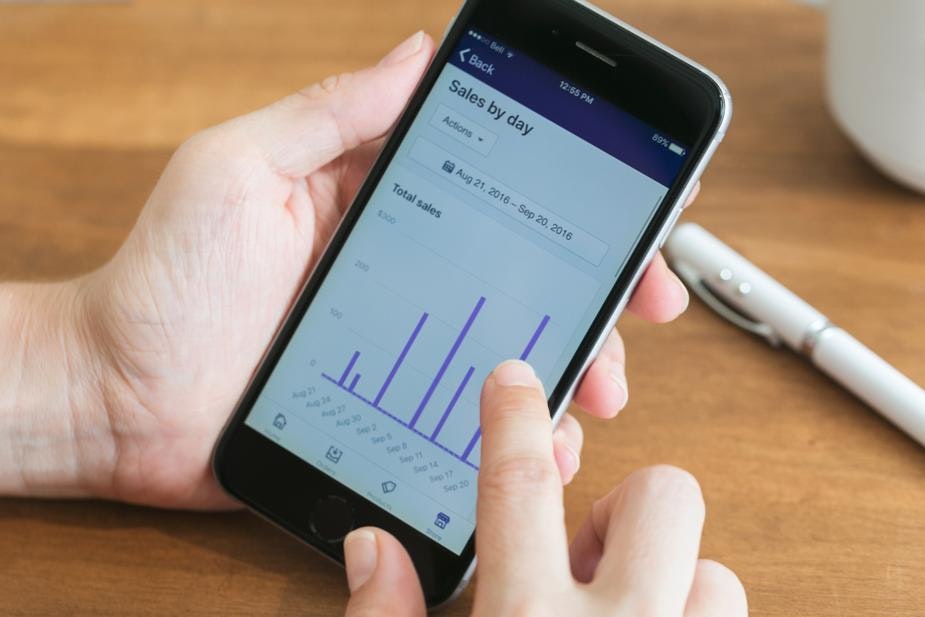
Our colleagues in France spoke to a young 24-year-old merchant who grew up in the Paris region. Nourdine became a dropshipper in April 2019. He shared his journey and ups and downs during his first year of entrepreneurship.
An Entrepreneurial Soul
After graduating from high school, Nourdine planned to work in innovation while studying engineering. However, from a young age, he wanted to become an entrepreneur, create something from scratch, and manage his own business.
“In today’s educational system, people tend to talk more about entrepreneurship but mostly highlighting startups. They never talk about more traditional entrepreneurship, like having a shop, so for me, being an entrepreneur was creating a startup.”
With a startup idea in mind, Nourdine started working on his first project but soon realized that it was difficult to find partners or raise funds. At the same time, he became passionate about the different types of online businesses and discovered the dropshipping model.
“As a skeptic, I watched dropshipper videos on YouTube but thought it was too good to be true. I thought it could only be a scam. But I then heard about Shopify in a video and realized it was quite easy to create an online store.”
In January 2019, he launched a first online store selling interior design accessories, including lamps found through AliExpress.
“I was a student, so I wasn’t making any money, and I couldn’t afford the Shopify subscription. I challenged myself to achieve a sale during the trial period – and that was my first failure!”
He boosted his Facebook post with 10 euros, published his first ad with a picture he randomly found and didn’t spend any time on targeting. Looking back, he knows it couldn’t have worked out.
Following this failure, he decided to prepare his mid-term exams and put his entrepreneurial ambitions on hold.
The Epiphany
Nourdine then went on to work as an intern where he discovered the pressures of working on projects and under managers. He did a six month internship in a large consulting firm in the Paris business district. His day consisted of a suit and tie, being at the office at 9 am and spending all day on Excel sheets.
“I felt out of place. I didn’t feel like I was making a difference. I felt limited and boxed inside. It was a really bad experience. I had a pattern that changed with every new client assignment. I remember being in my office, stuck in front of my Excel files, and I couldn’t move. Working for these big companies is like slavery to me! I had this vision, like many others, that working in the business district was a successful life. But I didn’t like this life! And then I told myself that even though I had my future all mapped out, my life couldn’t come down to that.
I needed a feeling of freedom. I wanted to go in my own direction, not take orders. So, over the weekend, I started setting up new shops.”
First Dropshipping Successes
In April 2019, Nourdine went back to dropshipping and launched new online shops. Among them was a cap shop that he began promoting with a specially-created Instagram page. By regularly posting products and using the right hashtags, he was able to drive free traffic to his shop and generated his first few sales. He reached €300 in sales by selling around 50 caps.
“I remember my first sale very well; a young man ordered a cap from my online shop. It gave me a boost. I told myself that everything was possible.”
But he then learned the second lesson in marketing. His target audience was teenagers, and he quickly realized that many visitors added an item to their shopping cart, but didn’t make the purchase. His target had no purchasing power.
His key takeaway from that experience was realizing that he needed to target compulsive buyers to increase his chance of success. At the same time, he decided to experiment with a women’s clothing store targeting US customers. To promote his store, he chose influencer marketing.
“I paid a few influencers out of my own pocket to promote my shop, but it didn’t work. And I didn’t want to use affiliate marketing. Another lesson learned was: I didn’t want to depend on someone and have an intermediary between me and my potential customers. On Facebook, I’m the one who manages my ads, my budget. It’s much easier”.
So Nourdine set out to upskill in dropshipping and digital marketing by watching YouTube and reading blog posts to refine his strategy.
In June, he saw his first dropshipper success with €4,000 sales thanks to a single product that was in the wellness niche and aimed to eliminate fat. He had invested what he had earned selling caps in Facebook advertising.
In July, he decided to launch a new store which propelled him to the top.
A New Dimension
Thanks to a niche and a winning product that he prefers to keep to himself, Nourdine quickly reached €1,000 in sales per day with a 50 percent net profit. Soon after that, he was making €2,000 in sales per day, all thanks to Facebook ads.
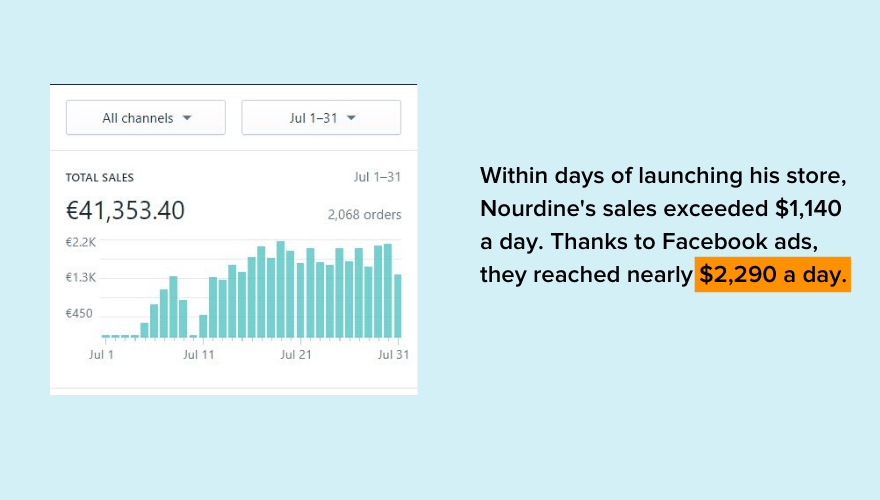
Nourdine found his product using the Adspy app, which tracks Facebook ads and identifies products that could become a hit. The product he sold already worked well in the US but was not yet available in France.
He increased his Facebook budget to over €1,500 a day, generating daily sales between €4,000-5,000 on average. His total sales reached €80,000 in three weeks. He controlled his budget using Excel sheets, tracking every penny.
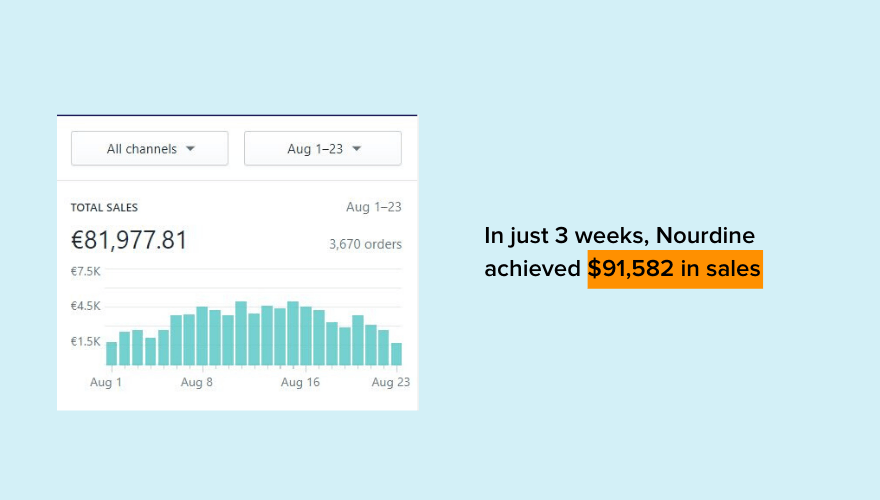
All of this happened in just a few weeks, all while Nourdine was still an intern.
“This turnover, which was constantly increasing, turned a lot of things upside down with regards to my vision of the job. I spent 99 percent of my time in a company that hardly paid me and one percent on something that brought me several thousand euros in net profit in a few days. In one day, I made more money than my monthly salary!”
“I’m not a big spender. I decided to keep my money to invest in other Facebook ads and other business ideas. The only thing that changed then was my lunches: I used to eat a sandwich, but as soon as I started making money, I indulged in a few restaurants!”
In August, he continued to sell and expanded from a single product online store to a store with three or four products in the same niche. Nourdine also started regularly working with an agent who allowed him to source new products and to negotiate the price. This is a critical step to continue in the dropshipping business.
“[Dropshippers] are very vulnerable when it comes to products and stock. We don’t control the quality of our products, so we have to partner with impeccable suppliers that we can trust.”
During this period, Nourdine trained in customer relationship management (CRM) and acquired new skills to understand his niche and clients better.
Dropshipping: Success and Instability
But dropshipping is a very competitive environment, and others started to sell the same product.
“I continued to generate sales despite it all, but an influencer in my niche criticized my shop, claiming it was a dropshipping site, a scam. I found this criticism quite harsh and unsubstantiated because I was spending a lot of time on CRM and giving advice to keep my customers satisfied. I really didn’t want to make money at the expense of customers and I was only making a small margin with my advertising investments on a product sold for €20. I started getting return requests because of this video, so I decided to discontinue my store at the end of August.”
Despite this, Nourdine considered himself extremely successful. In less than two months, he achieved over €123,000 in sales and €50,000 of net profit.
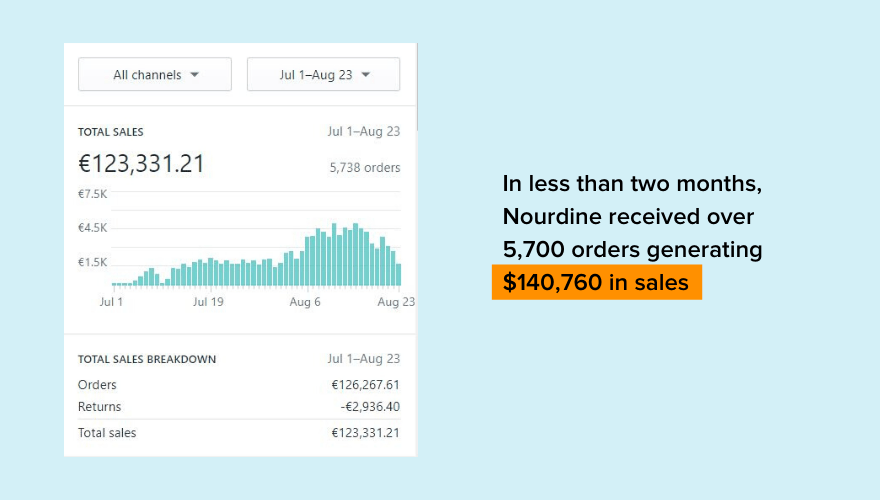
Since the end of August 2019 and the closure of his first store, Nourdine has continued to create stores and generate robust sales. Unfortunately, the COVID-19 crisis has slowed down the factories in China, and in response, he closed his stores between January and March. However, with the reopening of the factories, Nourdine has been able to resume his activities. But, with high delivery costs, his profit margins have been reduced. With that said, in general Nourdine can’t complain because he operates in one of the few industries that was barely impacted by COVID.
5 Tips for a New Dropshipper
We asked Nourdine what advice he would give to young people who want to get into entrepreneurship and dropshipping. Here’s what he had to say:
1. Get started today

His first piece of advice is: Do not wait and start today. There will always be excuses or good reasons not to start. You’re never fully ready. The best moment to become an entrepreneur is now.
2. Have a good product
The most important element for Nourdine is the choice of your product. That’s what your marketing is based on. When you choose a niche, you have to get to know it, acquire skills to be credible, and have impeccable customer service.
To succeed, you either have to find an innovative product, be the first to sell it, or be the first to solve a real problem. Products that sell well are often those that are useful, but also those that can be bought again and again – such as products in the beauty niche.
3. Constantly renew yourself
Everyone can succeed, but only one percent of dropshippers do. People fail because they don’t keep up with the competition or possess the level of persistence that ecommerce requires. You need to have the capacity to adapt and change products or store quickly if you are no longer selling. Dropshipping is a powerful business model, but it is unstable. You can’t be afraid of failure; you have to be resilient. You also shouldn’t expect regular income. You can hit the jackpot for a month and then sell nothing for several months. That’s why you have to be in control of your money and spend it wisely.
“I launched 30 or 40 stores in my first year as a dropshipper. I made an interesting turnover with only four shops. You have to constantly test, reinvest, keep track of your data and budget, and learn to deliver better performance.”
Building an online shop doesn’t require a considerable amount of work. Nourdine says it only took him a few hours as he often used the same Shopify theme.
“I also recommend finding a generic shop name that can go everywhere no matter what product you’re testing. That way, you don’t have to buy a new domain name every time you start a shop.”
4. Master Facebook Ads
“We really need to learn and master digital marketing because it’s our only asset.”
The Facebook Pixel is a powerful algorithm that helped Nourdine understand his audience and track their every move. Data analysis is crucial to ensure profitability and anticipate your next step. Nourdine usually tests a Facebook ad allowing himself to “lose” up to €100. If it fails to perform above this budget, he shuts down the campaign and creates another one, sometimes with a different product.
5. Exchange with other dropshippers
Entrepreneurship can be very lonely. That’s why Nourdine participates in several ecommerce events or those organized by the dropshipping community in France. It’s important for him to exchange, network, and share good practices. He also wants to help train dropshipping beginners or people who wish to market their own products through digital marketing.
What’s Next for Nourdine?
Among his many projects, Nourdine wants to be able to source his products in Europe and keep stock. He wants to grow more and more credibility and ethics in his entrepreneurial project. He also likes the satisfaction of being able to create jobs. He has already hired people to do customer service from Madagascar and Morocco.
“I would also like to create my own brand, create a ‘made in France’ ecommerce business.”
Dropshipping allows Nourdine to generate cash flow, but it’s unstable. So, he’s thinking about other business ideas that are more stable.
“I still want to create my startup in innovation. But I want to be able to do my own fundraising thanks to dropshipping! So that the future or success of my company doesn’t depend on this mad rush to raise money or the goodwill of investors.”
We wish Nourdine a lot of success and look forward to seeing the next step in his journey.



